Overview
To get rid of B Belly, individuals should focus on making effective lifestyle changes, including dietary adjustments, regular physical activity, stress management, adequate sleep, and hydration. The article emphasizes that these strategies, supported by research and personalized coaching, can significantly reduce abdominal fat by addressing its underlying causes and promoting overall health.
Introduction
In the quest for a healthier lifestyle, the battle against B Belly fat emerges as a significant challenge for many individuals, particularly men. Often associated with poor dietary choices and sedentary habits, this type of abdominal fat not only affects physical appearance but also poses serious health risks.
Understanding the multifaceted causes behind B Belly is crucial, as it encompasses a blend of genetic, hormonal, and environmental factors. As society becomes increasingly aware of the importance of wellness, exploring effective strategies for reducing B Belly fat—ranging from lifestyle changes and targeted exercises to surgical options—becomes essential.
This article delves into the complexities of B Belly, offering insights and practical solutions to empower individuals on their journey toward a healthier, more confident self.
Understanding B Belly: Causes and Characteristics
B Belly specifically refers to a distinct type of abdominal fat that protrudes prominently in men, often described as a 'beer belly.' This condition can stem from a combination of dietary habits, insufficient physical activity, and hormonal fluctuations. Stress and the high consumption of processed foods significantly contribute to the accumulation of fat around the midsection.
According to research, individuals with a waist circumference exceeding 40 inches (102 cm) may face unhealthy levels of belly fat. To effectively get rid of B Belly, it is essential to recognize the underlying causes, including lifestyle choices that drive its development. As Inna Melamed, a doctor of pharmacy and gut hormones expert, notes, 'Countless experiences affect the microbiome in toddlers, including factors like whether a child was born via C-section or breastfed.'
This insight underscores the lifelong impact of early life choices on health, suggesting that such factors may influence susceptibility to conditions like B Belly in adulthood. Additionally, a case study titled 'Contributing Factors of Obesity' highlights that obesity is a multifaceted disease influenced by economic, health, and environmental inequities. Recommendations from this study, such as consuming nutrient-dense foods and engaging in regular exercise, can help get rid of B Belly by addressing the contributing factors.
Furthermore, it's worth noting that the prevalence of childhood obesity declined from 15.9 percent to 14.4 percent among children ages two to four in the WIC program from 2010 to 2020, indicating positive trends in lifestyle changes that can impact future generations. By understanding these influences, individuals can empower themselves to implement changes that promote healthier living and ultimately get rid of B Belly.
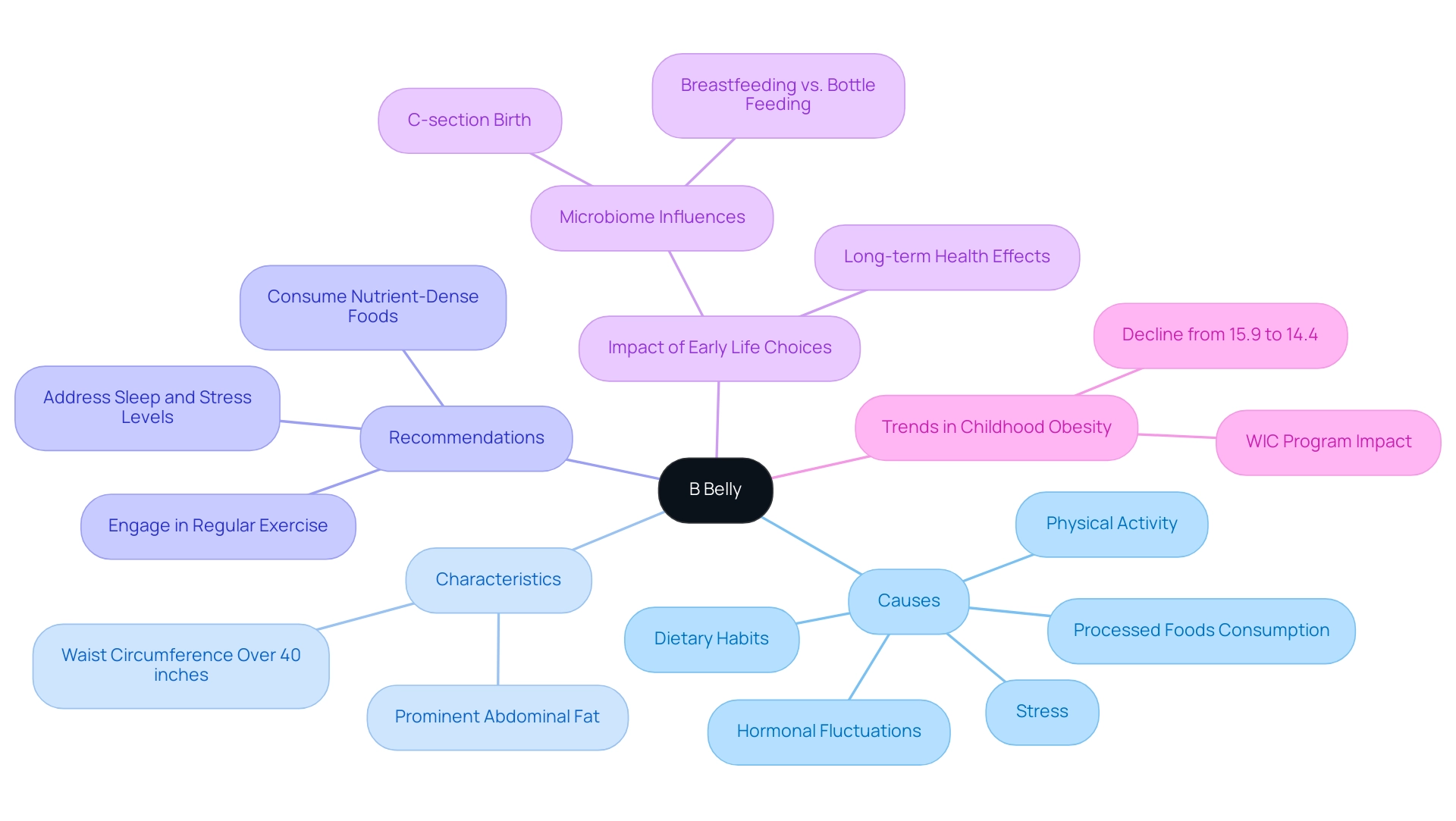
Why B Belly Fat is Difficult to Lose
Abdominal fat, commonly known as B Belly, poses considerable difficulties regarding how to get rid of B Belly, mainly because of a mix of hormonal and genetic influences. Elevated cortisol levels, commonly associated with stress, have been linked to increased abdominal fat storage. According to the American College of Obstetricians and Gynecologists, "it is unethical for obstetrician-gynecologists to refuse to accept a patient or decline to continue care that is within their scope of safe practice solely based on an arbitrary BMI cutoff or because the patient has obesity."
This highlights the importance of adopting a holistic approach rather than relying solely on BMI thresholds, especially considering that 65% of SART member programs in the United States had a declared BMI threshold. Genetic predispositions also play a crucial role; certain individuals may find it particularly difficult to get rid of B belly fat due to inherited traits that affect fat distribution. Furthermore, the prevalence of sedentary lifestyles, especially in workplace environments, compounds these issues.
Physical activity is essential not only for burning calories but also for improving metabolic health. Our comprehensive wellness coaching app addresses these challenges by offering personalized workouts and nutrition guidance, empowering users to make lasting lifestyle changes. The daily programming feature ensures that you stay on track with your goals and commitments, providing the convenience of accessing personalized workouts, lessons, and nutrition guidance whenever and wherever you are.
Users like Sarah, who lost 15 pounds in three months, have praised the app for its ease of use and the support they received from experienced coaches. A case study titled 'Reduction in Body Mass and Hormonal Changes' shows that decreasing body mass through diet, exercise, or bariatric surgery can enhance insulin resistance, diminish inflammation, and positively influence obesity hormones. Achieving a successful reduction in body mass is linked to a lower risk of developing heart disease, stroke, type II diabetes, and certain cancers.
By comprehending these elements and utilizing the assistance of skilled trainers via our easy-to-use app, you can create successful strategies for reducing body mass and get rid of B belly.
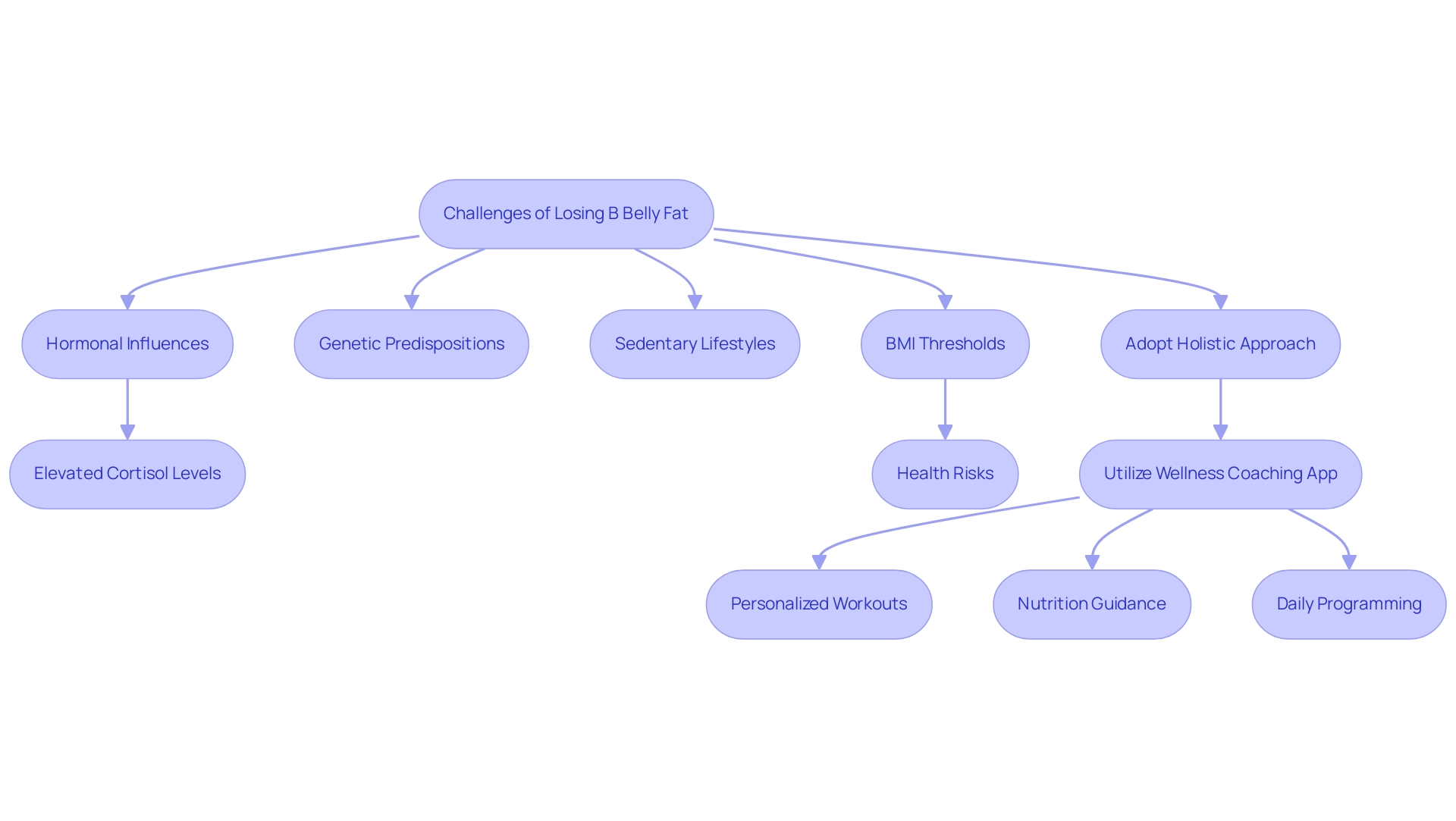
Effective Lifestyle Changes for Reducing B Belly
To effectively combat B Belly fat, consider incorporating the following lifestyle changes supported by Foresight Health Coaching's comprehensive programs:
- Dietary Adjustments: Emphasize a balanced diet abundant in whole foods such as fruits, vegetables, lean proteins, and healthy fats. Foresight highlights that research indicates higher protein and fiber densities are associated with significant reductions at various intervals—3, 6, and 12 months. A case study titled "Factors Affecting Weight-Loss Outcome" highlights that these dietary components play a crucial role in managing body mass. Limiting processed foods and sugars can help get rid of b belly fat accumulation, making these dietary changes crucial for abdominal fat reduction.
- Regular Physical Activity: Strive for a minimum of 150 minutes of moderate aerobic exercise each week, supplemented by strength training routines. Foresight’s personalized fitness coaching can assist individuals in incorporating beneficial activities like walking, cycling, and resistance training, which not only aid in burning calories but also improve muscle mass, further increasing metabolism and encouraging fat reduction.
- Stress Management: Incorporate stress-reducing techniques like yoga, meditation, or deep-breathing exercises into your daily routine. Foresight’s wellness workshops emphasize that lowering cortisol levels through these practices can significantly help get rid of B belly by decreasing fat storage in the abdominal region, addressing one of the physiological contributors.
- Adequate Sleep: Aim for 7-9 hours of quality sleep nightly. Research consistently connects inadequate sleep habits with body mass increase and heightened fat storage, emphasizing the significance of rest in any fat reduction approach.
- Stay Hydrated: Maintain hydration by drinking ample water throughout the day. Adequate hydration aids metabolic functions and can help control unnecessary cravings, which is essential in a journey to reduce body mass.
In addition to these lifestyle adjustments, Foresight Health Coaching offers corporate memberships that provide tailored wellness solutions for employees. These memberships include in-person wellness talks, nutritional services, and access to our health and wellness app, which supports users in tracking their progress and connecting with a community for motivation. By implementing these comprehensive strategies, individuals can foster a healthier routine that effectively helps them to get rid of B Belly fat.
With 40% of Gen X women concentrating exclusively on dieting, as reported, and with Weight Watchers boasting 5 million subscribers and $334 million in revenue during the second quarter of 2020, these strategies reflect both dietary and physical activity trends that contribute to successful weight reduction transformations, all supported by Foresight's tailored coaching services.
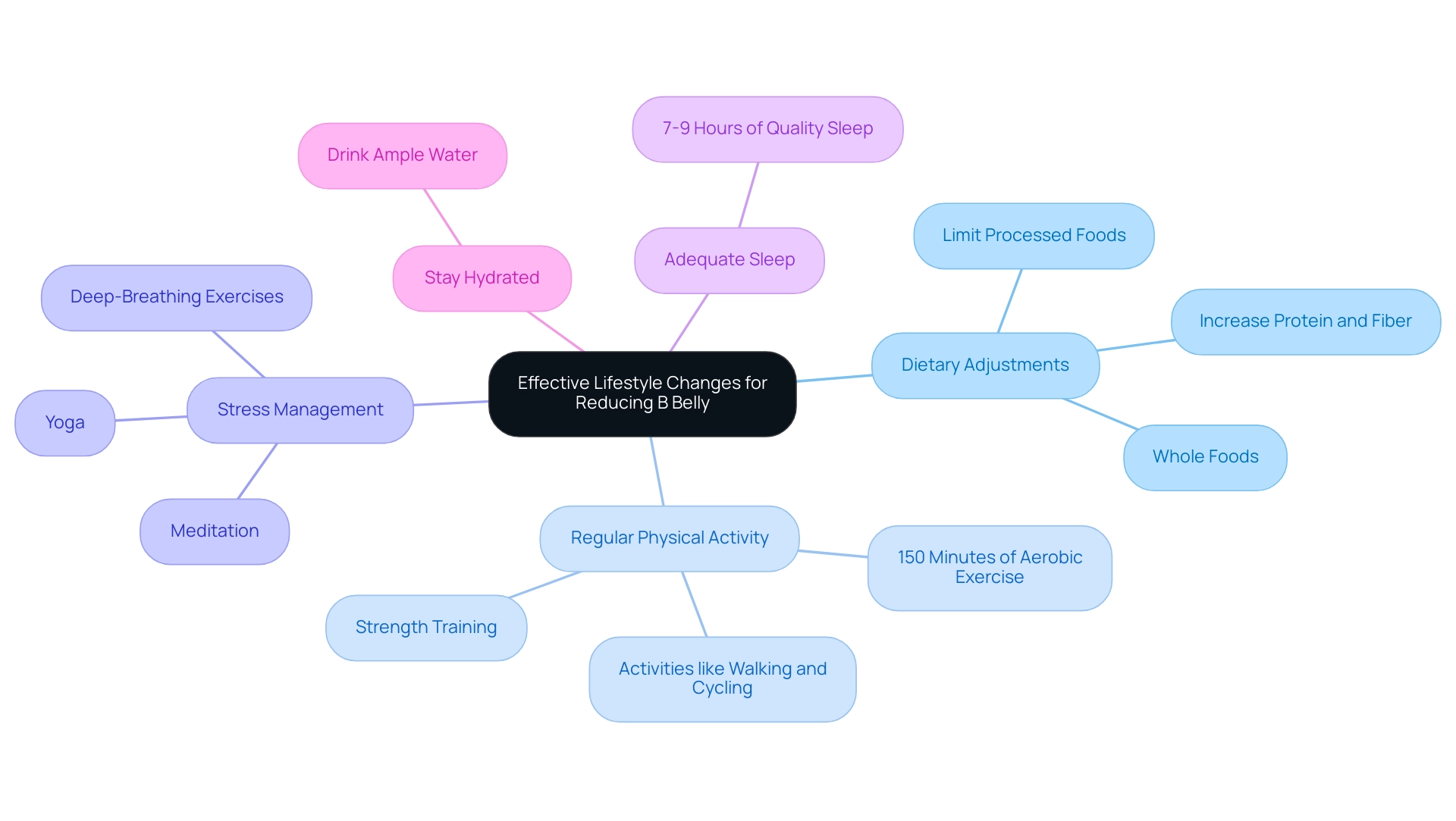
Targeted Exercises to Combat B Belly Fat
To effectively reduce B Belly fat, targeted exercises play a crucial role in helping you get rid of B belly. Incorporate the following workouts into your routine:
-
Core Strengthening Exercises: Engage in workouts such as planks, Russian twists, and leg raises.
These exercises not only build core strength but also help tone the abdominal region, making them essential to get rid of b belly.
-
High-Intensity Interval Training (HIIT): This method involves alternating short bursts of intense exercise with rest periods.
HIIT has proven to be highly effective for burning calories and can help you get rid of b belly.
For instance, alternating between sprinting and walking or cycling can maximize fat reduction in a shorter time frame.
-
Cardiovascular Workouts: Activities like running, swimming, or cycling are excellent for calorie burning and overall fat reduction.
These exercises enhance cardiovascular health and significantly help to get rid of belly fat.
-
Resistance Training: Incorporating weightlifting or bodyweight exercises can increase muscle mass, which is instrumental in boosting metabolism.
Enhanced metabolism leads to more calories burned even while at rest.
To achieve optimal results, aim to incorporate these exercises into your routine at least 3-4 times a week.
The findings from recent studies indicate that a structured training program can yield an adherence rate of around 80%, even among sedentary, unfit, obese women, highlighting the accessibility and effectiveness of such a regimen.
This aligns with the statistic from the Journal of Pediatrics, which includes 148 clinical citations supporting the effectiveness of exercise interventions.
Remember, when encountering claims of 'one trick' solutions, as the saying goes, it's important to discern that the primary goal may be product sales rather than genuine assistance in your fitness journey.
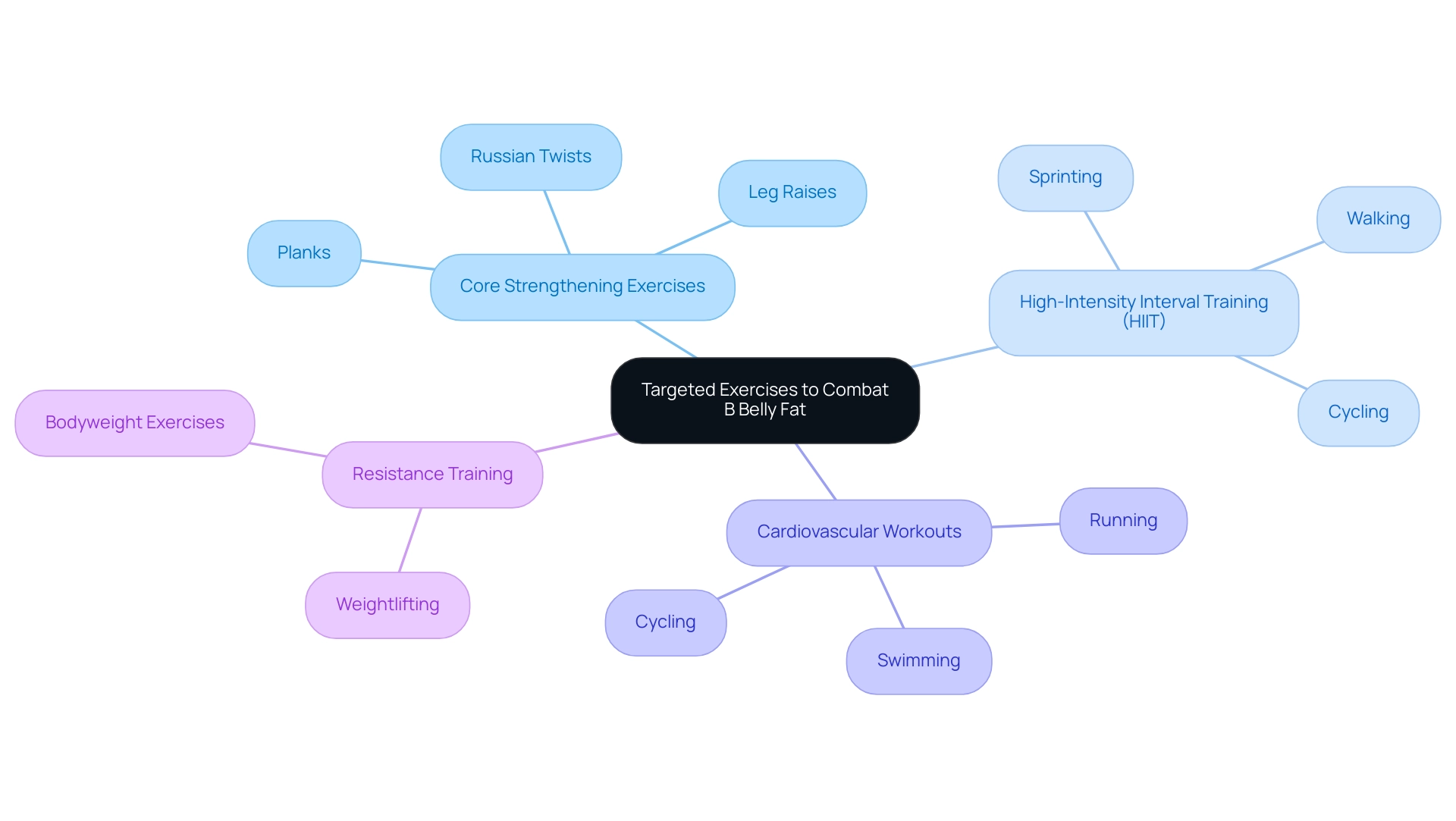
Surgical and Non-Surgical Solutions for B Belly Fat
For individuals struggling to shed belly fat despite lifestyle modifications, a variety of surgical and non-surgical options are available:
- Liposuction: This surgical procedure effectively targets fat removal from specific areas, including the abdomen. Recent studies highlight a significant variance in the volume of fat removed, with averages reported at 4,990 mL in some cases compared to 3,373 mL in others. Rudolph H. de Jong notes, "The work of Grazer and de Jong is arguably the most extensive compilation of liposuction deaths to date," emphasizing the importance of understanding the potential risks associated with the procedure, including fat embolism and pulmonary venous thromboembolism.
- CoolSculpting: As a non-invasive procedure, CoolSculpting utilizes controlled cooling to freeze fat cells, which the body subsequently eliminates over time. Effectiveness studies indicate that this method can be particularly beneficial for those aiming to get rid of belly fat without undergoing surgery.
- Gastric Bypass Surgery: For individuals dealing with obesity, gastric bypass surgery provides a practical solution to get rid of belly fat and achieve substantial reduction in body mass. This procedure necessitates a thorough medical evaluation and a commitment to post-surgical lifestyle changes to ensure lasting results. It is important to note that a case study analyzing perioperative deaths associated with cosmetic surgery highlighted significant risk factors, including high BMI and multiple procedures, underscoring the need for careful consideration.
- Medications: Various medications are available to assist with weight loss; however, they should only be pursued under the guidance of a healthcare professional to ensure safety and efficacy.
Public health authorities recommend that individuals considering cosmetic surgery discuss risks with their healthcare professionals, emphasizing the importance of preoperative evaluations and caution against multiple procedures. Considering the complexities and risks linked to these interventions, seeking advice from a healthcare provider is essential to customize the best approach based on individual health profiles and objectives.
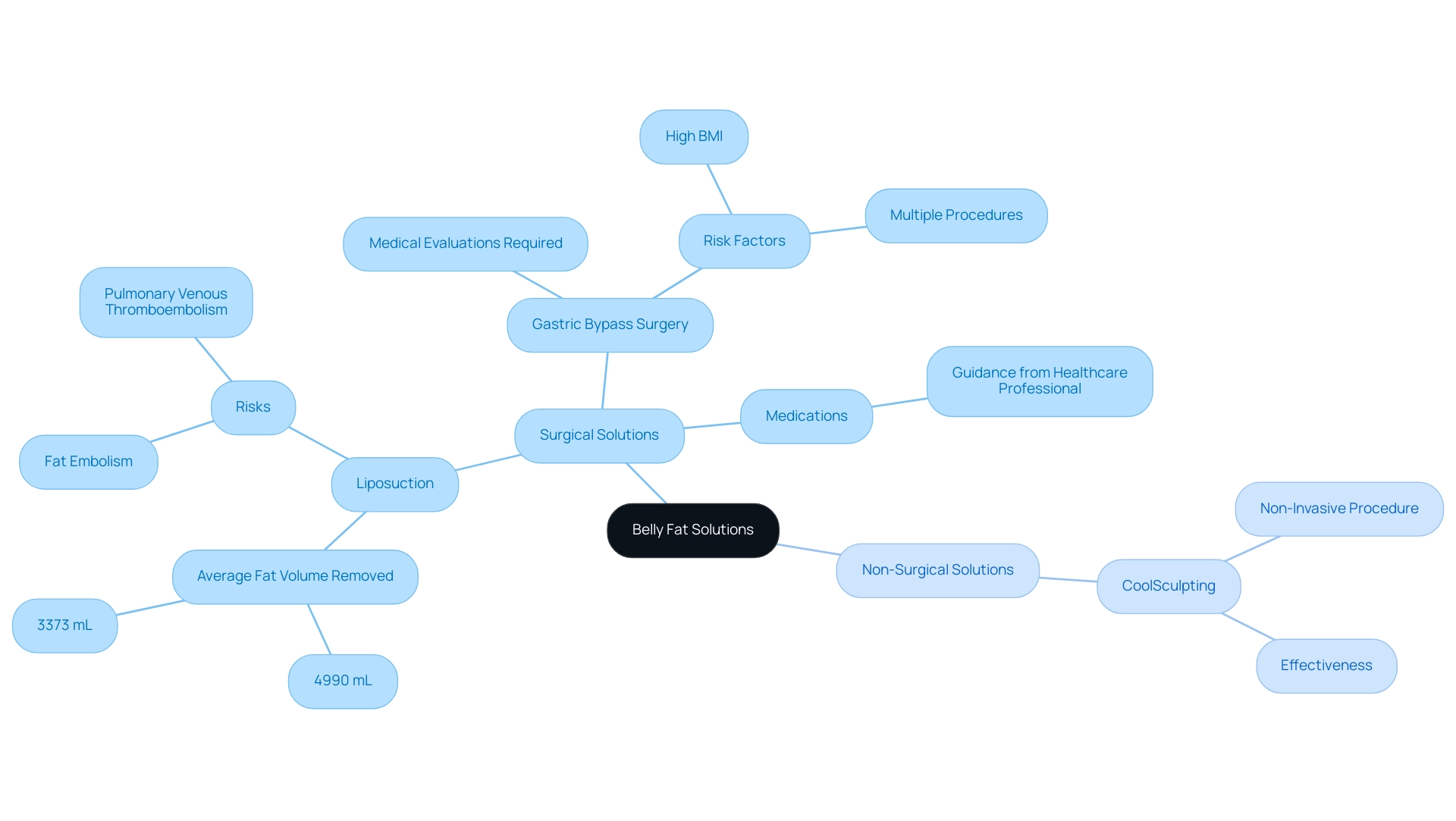
Staying Motivated: The Mental Aspect of Reducing B Belly
Maintaining motivation during the journey to get rid of b belly is crucial for achieving lasting success. Consider implementing the following strategies, enriched by personalized coaching and experienced guidance, to foster a positive mindset and enhance your chances of reaching your goals:
- Set Realistic Objectives: Establishing achievable, measurable objectives is vital. This approach not only helps track progress but also prevents feelings of being overwhelmed. Celebrating small victories can significantly boost morale, leading to sustained motivation. Seasoned trainers highlight that simplifying target setting in a nurturing atmosphere increases the chances of attaining fitness objectives. One client shared, "With my coach's assistance, I established small, achievable targets that kept me motivated throughout my journey."
- Find a Support System: Involving friends, family, or colleagues in your journey to shed pounds can offer invaluable support. Sharing your objectives fosters accountability and encouragement, which are essential for overcoming challenges. A recent study revealed that 19% of participants experienced positive changes in their reduction efforts through supportive environments, underscoring the importance of social support and personalized guidance in achieving objectives. "Having my family involved made a huge difference in my motivation," noted another client.
- Keep a Journal: Documenting your food intake, exercise routines, and emotional state can help identify patterns and keep you focused on your objectives. This reflective practice can illuminate both positive and negative factors influencing your journey, allowing for adjustments along the way. Insights from the case study titled 'Factors Influencing Weight Loss Success' showed that participants who reported fewer negative factors, such as health issues and stress, were more likely to attain their weight loss objectives. Coaches often recommend journaling as a way to gain insights and stay accountable.
- Visualize Success: Visualization techniques can be powerful motivators. Imagining the benefits of a flatter stomach not only reinforces your commitment but also cultivates a mental image of success that pushes you forward, supported by the knowledge and skills you gain through personalized coaching. As one client reflected, "Visualizing my success helped me stay concentrated on my objectives, especially during tough times."
- Practice Self-Compassion: It’s important to acknowledge that setbacks may occur. Being kind to yourself during challenging times is crucial; focus on the progress made rather than the pursuit of perfection. Coaches often remind clients that self-compassion is key to maintaining motivation and resilience.
By nurturing a positive mindset and applying these strategies, individuals can significantly improve their chances of successfully getting rid of b belly. With the help of experienced coaches and a supportive community, focusing on realistic, clinically impactful goals may pave the way for a transformative journey towards empowered well-being.
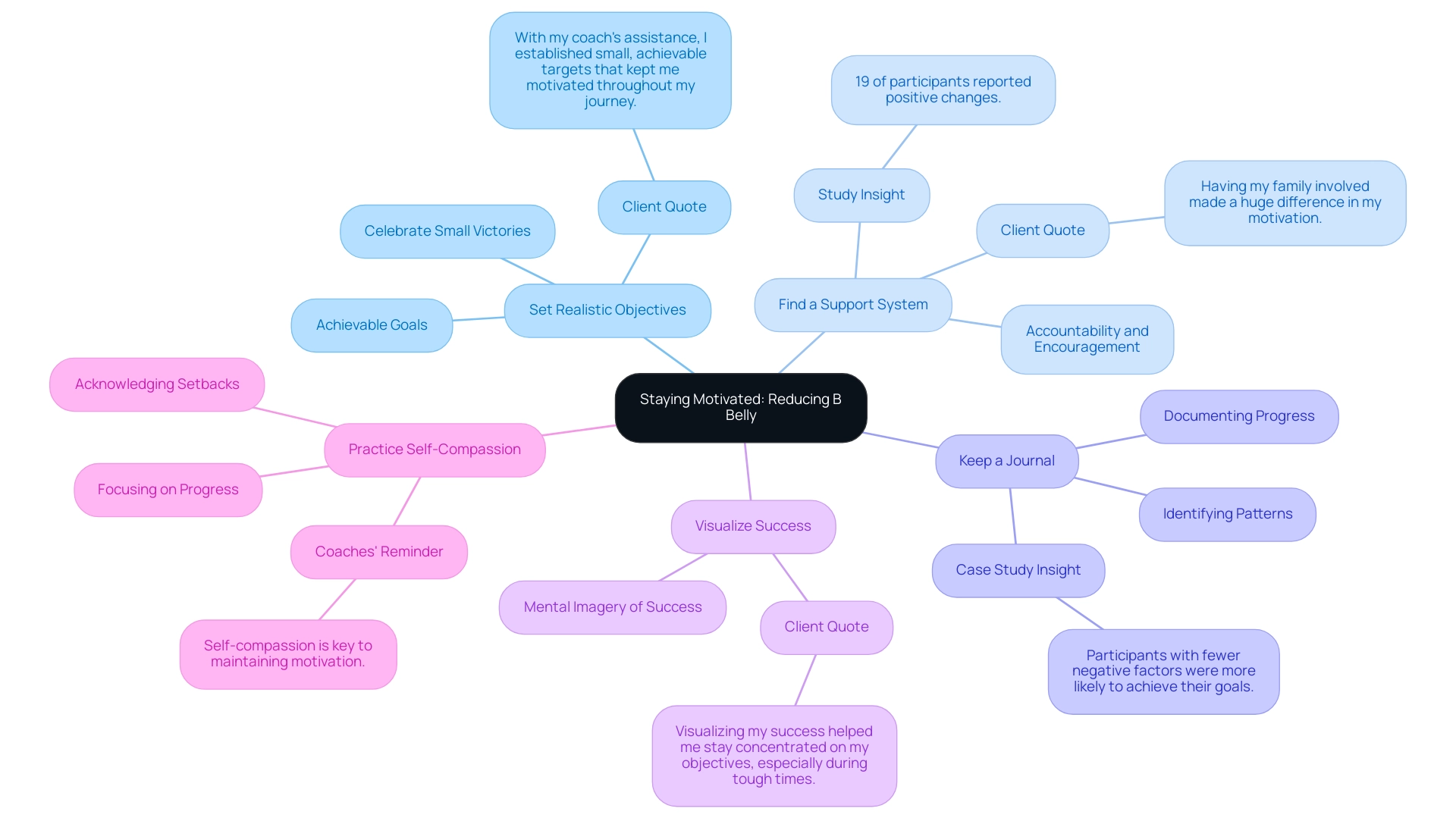
Conclusion
Belly fat, particularly B Belly, presents a multifaceted challenge that requires a comprehensive approach to address effectively. Understanding the various causes—from poor dietary choices and sedentary lifestyles to hormonal influences—can empower individuals to make informed decisions that support their health goals. The article highlights the importance of recognizing these factors, as they play a crucial role in the accumulation of abdominal fat and overall well-being.
Incorporating lifestyle changes such as adopting a balanced diet, engaging in regular physical activity, managing stress, and prioritizing sleep can significantly aid in reducing B Belly fat. Targeted exercises, including core strengthening and high-intensity interval training, further enhance these efforts, promoting muscle growth and fat loss. For those who struggle despite these changes, surgical and non-surgical options are available, but they should be approached with caution and under professional guidance.
Moreover, maintaining motivation is essential for long-term success. Setting realistic goals, seeking support from others, and practicing self-compassion can foster a positive mindset that encourages persistence. By combining these strategies with personalized coaching, individuals can create a sustainable path towards a healthier lifestyle and reduce B Belly fat effectively.
Ultimately, the journey to combat B Belly is not just about aesthetics; it is about enhancing overall health and well-being. By understanding the complexities of this condition and implementing practical solutions, individuals can achieve not only a flatter stomach but also improved health outcomes, paving the way for a more confident and vibrant life.
Frequently Asked Questions
What is B Belly?
B Belly refers to a distinct type of abdominal fat that protrudes prominently in men, often described as a 'beer belly.' It can result from dietary habits, insufficient physical activity, and hormonal fluctuations.
What factors contribute to the development of B Belly?
Factors contributing to B Belly include stress, high consumption of processed foods, lifestyle choices, and early life choices that affect the microbiome, such as being born via C-section or being breastfed.
How does waist circumference relate to health risks associated with B Belly?
Individuals with a waist circumference exceeding 40 inches (102 cm) may face unhealthy levels of belly fat, which can lead to various health issues.
What recommendations can help reduce B Belly?
Recommendations for reducing B Belly include consuming nutrient-dense foods, engaging in regular exercise, and addressing underlying lifestyle factors that contribute to its development.
How does childhood obesity relate to B Belly?
The decline in childhood obesity rates among children ages two to four in the WIC program from 2010 to 2020 indicates positive trends in lifestyle changes that may impact the prevalence of B Belly in future generations.
What role do genetic predispositions play in B Belly?
Genetic predispositions can make it particularly difficult for some individuals to reduce B Belly fat due to inherited traits that affect fat distribution.
Why is physical activity important for addressing B Belly?
Physical activity is crucial for burning calories, improving metabolic health, and combating the sedentary lifestyles that contribute to abdominal fat accumulation.
How can wellness coaching apps assist in reducing B Belly?
Wellness coaching apps provide personalized workouts and nutrition guidance, helping users implement lasting lifestyle changes and stay on track with their health goals.
What are the health benefits of successfully reducing body mass?
Successfully reducing body mass can enhance insulin resistance, diminish inflammation, and lower the risk of developing heart disease, stroke, type II diabetes, and certain cancers.

